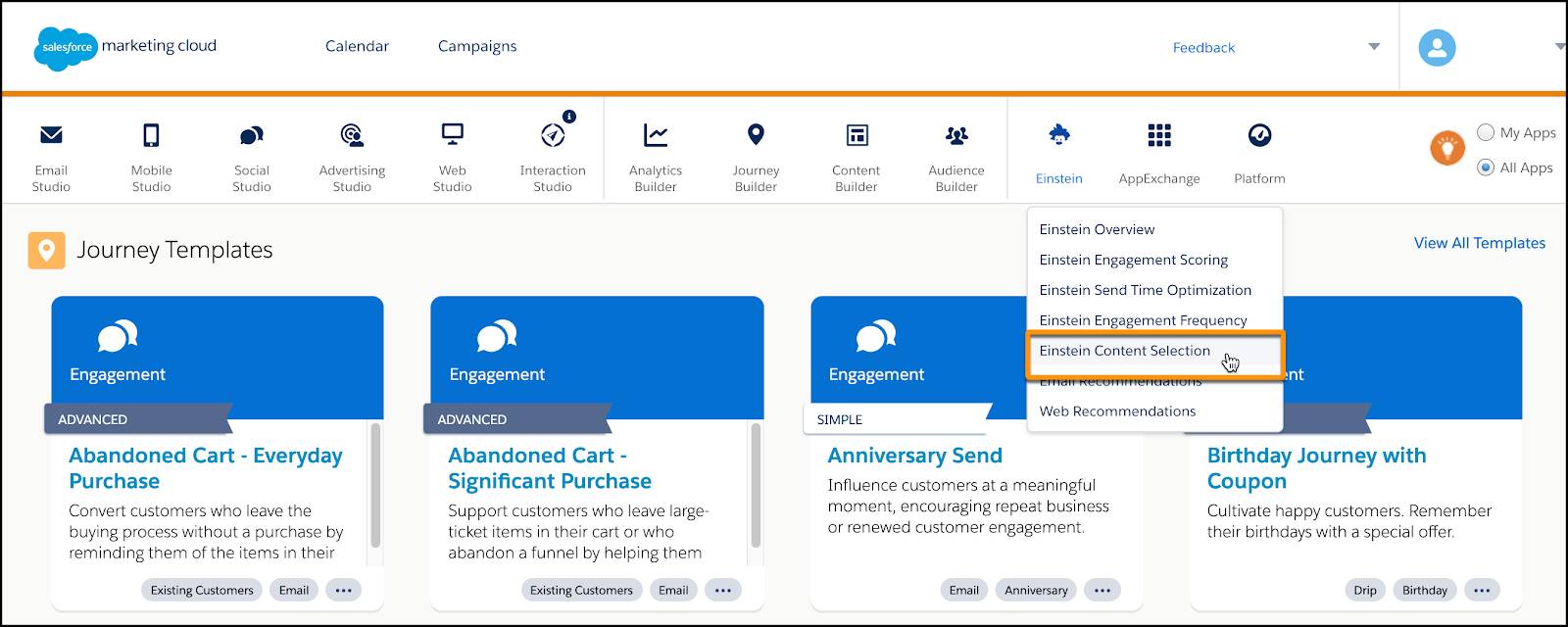はじめての Einstein コンテンツ選択
学習の目的
この単元を完了すると、次のことができるようになります。
- Einstein コンテンツ選択を有効化する。
- Einstein コンテンツ選択を操作する。
- パフォーマンス分析と利用可能な設定を確認する
選ぶのは Einstein にお任せ
ロボットがメールを代行して作成することは (現時点ではまだ) できませんが、人工知能 (AI) は、顧客に送信すべきコンテンツの選択を手助けできます。具体的には、Einstein コンテンツ選択が既存のアセットをレビューして、購読者ごとに最も関心が高いと思われるコンテンツを選択します。自分で推測することはもうやめて、Einstein コンテンツ選択に判断を任せましょう。このモジュールでは、Einstein コンテンツ選択を初めて使う方のために、有効化からコンテンツアセットの追加までの手順を説明します。
AI を利用したコンテンツ選択のしくみ
すべての始まりはマーケティングコンテンツです。Einstein コンテンツ選択では、これをアセットと呼びます。次に、メタデータ、顧客プロファイル、簡単なビジネスルールを追加します。Einstein コンテンツ選択ブロックを使用してメールを送信する準備ができたら、システムは利用可能なコンテンツを分析し、ビジネスルールを探して、購読者が最もクリックする可能性が高いと思われるコンテンツを選択します。Einstein は、反応がよい顧客のクリック傾向を継続的に分析して、最も魅力的なコンテンツを求めて再評価を行います。このモデルでは、顧客がメールを開いた瞬間に、その時点で顧客にとって最適なコンテンツが選択されます。そのため、顧客がメールをすぐに開封しても、3 日後に開封しても、その人にとって常に最も魅力的なコンテンツが届けられることになります。
Einstein コンテンツ選択は柔軟性があり、自分のペースで機能を試しながら進めることができます。一歩ずつ進んで、準備ができたら次に進むことができるのです。では、最初のいくつかのステップを見ていきましょう。
-
アセットをアップロードする。Einstein コンテンツ選択が機能するためには、当然、コンテンツが必要です。アセットは、画像ベースのコンテンツブロックとして考えてください。Einstein コンテンツ選択に追加された各アセットには、関連情報 (属性と呼ばれます) も付与されています。アセットは、アセットクラスと呼ばれるグループで整理されます。
-
メールでアセットを使用する。アセットを追加してクラスに関連付けたら、Einstein コンテンツ選択のコンテンツブロックを作成して、メールのコンテンツをテストおよび最適化することができます。
その後、次の手順で Einstein コンテンツ選択をさらに利用できます。
-
ビジネスルールを設定する。オプションのビジネスルールを追加することで、コンテンツ選択をさらに絞り込むことができます。
-
顧客情報を追加して対応付ける。必要に応じて、プロファイル属性と呼ばれるコンシューマープロファイルデータを追加することで、顧客に合わせてコンテンツ選択をカスタマイズできます。これには、特定の購読者に関するメタデータを含めることでパーソナライズを促進する、属性データエクステンションを使用します。
Einstein コンテンツ選択の有効化
準備はよいですか? まず、Einstein コンテンツ選択を使用するための設定が完了していることを確認するために、有効化の手順をおさらいしましょう。
このモジュールでは、受講者が Marketing Cloud Engagement 管理者であり、Einstein 機能を有効化する適切な権限を有していると想定しています。ただし、Marketing Cloud Engagement の管理者でなくても問題ありません。このまま読み進み、本番組織でシステム管理者がこれらの手順をどのように実行するのかを見てみましょう。Trailhead Playground ではこの手順を実行しないでください。Trailhead Playground では Marketing Cloud Engagement を使用できません。
- Marketing Cloud Engagement で、[Setup (セットアップ)] に移動します。
-
Einstein Content Selection(Einstein コンテンツ選択) を検索して選択します。
-
[有効化] をクリックします。
これだけです。実際に使い始める前に、セットアップで購読者 ID、コンバージョントラッキング、アセットのアーカイブ、Einstein コンテンツタギング、および緊急時の画像設定などを調整してください。これらのオプションの詳細は、ヘルプページ「Einstein コンテンツ選択の設定」を参照してください。
Einstein コンテンツ選択のナビゲーション
Einstein コンテンツ選択を有効化しましたので、Einstein のメインドロップダウンメニューから Einstein コンテンツ選択にアクセスできるようになりました。 
このページから、[Asset Distribution (アセット配分)]、[Setting (設定)]、[Performance Analytics (パフォーマンス分析)] の 3 つのエリアに移動できます。では、各エリアを見ていきましょう。
Asset Distribution (アセット配分)
[Asset Distribution (アセット配分)] タブでは、Einstein コンテンツ選択アセットの内訳を視覚的に確認できます。[View All Assets (すべてのアセットを表示)] をクリックしてアセットのリストを表示し、必要に応じて追加のコンテンツアセットをアップロードします。このタブについては次の単元で詳しく説明します。![[View All Assets (すべてのアセットを表示)] ボタンが強調表示された Einstein コンテンツ選択の [Asset Distribution (アセット配分)] ページ。](https://res.cloudinary.com/hy4kyit2a/f_auto,fl_lossy,q_70/learn/modules/einstein-content-selection-basics/get-started-with-einstein-content-selection-/images/ja-JP/a4542a4ab41c6567c45c9182a812ac4e_kix.pu2sh3nacazo.png)
Settings (設定)
[Settings (設定)] タブでは、Einstein コンテンツ選択の高度な設定と機能を定義できます。これらを確認しておくと、Einstein コンテンツ選択の主要な概念を理解するのに役立ちます。詳しく見てみましょう。
![各オプションにコールアウトが付いている Einstein コンテンツ選択の [Advanced Settings (高度な設定)] ページ。](https://res.cloudinary.com/hy4kyit2a/f_auto,fl_lossy,q_70/learn/modules/einstein-content-selection-basics/get-started-with-einstein-content-selection-/images/ja-JP/e89c09ee8d39b6a661e438f58cb672b0_kix.6dwjkihyisss.png)
アセットクラス (1): アセットクラスは、類似する特徴を持つアセットのグルーピングです。一般的なクラスとしては、バナーや商品などがありますが、業界やビジネスニーズに合わせてカスタマイズできます。
アセット属性 (2): アセット属性は、Einstein がアセットについて把握する必要のある、関連付けられているメタデータ項目です。設定から、言語や活動などの独自の属性を追加して管理できます。
プロファイル属性 (3): アセット属性はコンテンツに関連付けられますが、プロファイル属性は購読者ごとに固有となります。プロファイル属性には、関心、お気に入りの趣味、居住国、希望する言語などがあります。
コンシューマープロファイル (4): 顧客情報を有するデータエクステンションを同期することで、Einstein コンテンツ選択にプロファイル属性が追加されます。
コンテンツ選択ルール (5): コンテンツ選択ルールにより、Einstein は顧客に合わせてコンテンツを微調整したりパーソナライズしたりできます。コンテンツ選択ルールの編集ページから、属性を対応付け、除外、疲労、および多様性ルールを設定できます。
フォールバックアセット (6): フォールバックアセットとは、設定したビジネスルールの条件に一致するコンテンツがない場合に購読者に表示される画像です。
Performance Analytics (パフォーマンス分析)
最後のナビゲーションエリアは、[Performance Analytics (パフォーマンス分析)] タブです。Einstein コンテンツ選択を使用してメールを送信すると、[Performance Analytics (パフォーマンス分析)] ダッシュボードから、アセットのパフォーマンスを評価することができます。

一意のクリック数、クリック開封率 (CTOR)、および個々のアセットのパフォーマンスの平均をアセットクラスごとに確認できます。イベントは毎日記録されて保存されます。また、アセットクラス、ジョブ (ID)、アセット属性に基づく日次レポートとしてダウンロードすることもできます。これらの分析は、クリエイティブチームと協力して新しいコンテンツを開発する際に役立ちます。
本当に多くの機能があります。先ほども述べましたが、すぐに高度な設定を使用しなくても、Einstein コンテンツ選択を活用することができます。最初はシンプルに行きましょう。次の単元では、Einstein コンテンツ選択にアセットを追加し、Einstein コンテンツ選択のコンテンツブロックを作成します。
リソース
- Salesforce ブログ: How to Use AI in Marketing (マーケティングでの AI の利用方法)
- Salesforce ヘルプ: Einstein コンテンツ選択
- Salesforce ヘルプ: Einstein コンテンツ選択の設定
- Salesforce ヘルプ: Einstein コンテンツ選択のパフォーマンス分析
